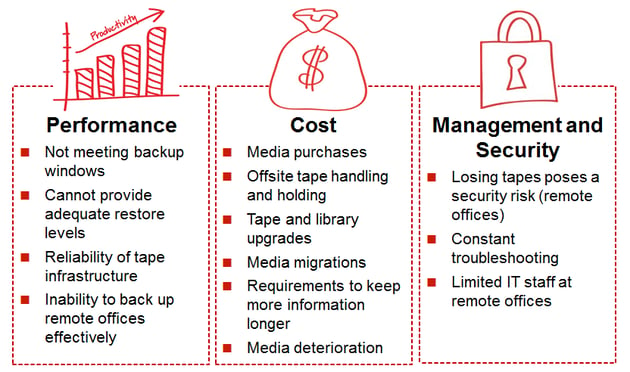A study by TheInfoPro highlighted that the top storage-related challenge faced by IT executives is managing storage growth. This is unsurprising given the rise in the number of devices, applications and programs in businesses. As storage requirements increase, a scalable storage solution becomes even more vital.
Clearly any discussion on storage is incomplete without addressing the issue of back up. Whether an organisation’s data is stored internally, in a cloud or at an external physical facility, reliable backup infrastructure is crucial. The IT executives surveyed by TheInfoPro agree backup administration and management is one of the top five problems faced by businesses, with application recoveries and back up retention a few spots below.
The Enterprise Strategy Group surveyed a number of organisations on virtualisation initiatives and results showed that backup and recovery of virtual machines came in as the second most important initiative with 37% of businesses citing it as a priority for FY12-13. Inspired by these results, Logicalis’ Solution Architect Dennis Dastoor conducted a briefing for Senior IT executives in Australia in early August 2013. The session focused on solving the current backup challenges faced by businesses like yours.
Why should backup be a big concern for you?
Aside from the obvious concerns of contingency planning and disaster recovery, there are a multitude of reasons firms should concern themselves with developing a backup strategy.
According to Dennis, traditional backup architecture is typically made up of many different components and moving parts, including backup agents, media servers, master servers, tapes and tape libraries. The right backup solution may involve up to five different vendors which all require different software, management and administration. Managing such a complex infrastructure generates a number of concerns.
The top three backup concerns:
- Performance
- Cost
- Managemet
The 5-step checklist to reliable backup:
Depending on your data storage facility, you may choose to manage backup and recovery internally.
Here is a 5-step checklist to guide you on the path to achieving reliable backup.
1. Can you guarantee the integrity of your backup data? Is data regularly checked?
2. Do you meet your backup window? Review your backup performance
3. Can you meet RPO/RTO objectives? Review your recovery performance
4. Can you scale to meet business growth? Will there be seamless service in the future?
5. Do you have service level agreements (SLA)? Are you meeting them?
Or alternatively you may choose to outsource this while you focus on your core business.
Logicalis has developed backup solutions to manage the pain of backup management away from businesses. We built three types of backup solutions to suit different business requirements.
- A Backup-as-a-Service (BaaS) solution provides a fully managed backup and recovery service of customer data, with on-premise infrastructure or a cloud-only offering with secure back-up to the Logicalis Cloud (Tier 3+ facilities located in Australia).
- A Backup Replication Service (BRS) replicates existing on-premise infrastructure to the Logicalis cloud with SLA-based data recovery, providing a higher level of backup protection and data retention.
Each of these solutions is backed by SLAs with detailed reporting of activities.
The business benefits
The three Logicalis backup solutions were designed to address the 5-step checklist above.
- When it comes to integrity of backup data, any solution should be equipped with fault detection and show data recovery ability, as well as performing regular score tests to validate the data stored.
- Look for the solution to identify and eliminate duplication within sets of data and send only unique data to the appliance, thereby dramatically reducing the backup windows required to protect your servers.
- To meet RPO/RTO objectives, backup services should be based on specific SLAs, which are subject to penalties.
- For scalability, back up solutions should encompasses capacity management to ensure that the required infrastructure can be added as your business grows.
Overall, your backup solution should aim to deliver operational efficiency through trained and certified staff and optimised processes around backup and recovery; and reduced risks through constant monitoring of backup processes and data security.




